
When it comes to the quality of out-of-camera JPEGs, I believe Fujifilm's X series cameras are second to none The main reason, as I pointed out on this page, is that in addition to choosing to shoot in JPEG, photographers can also select one of several film simulations, and each of these may be further tweaked to produce the best possible image under the given shooting conditions. How many of these simulations are available depends on the camera model; I mostly shoot with an X-T30, and descriptions of all 16 simulations usable with that camera are shown on the page inked to above.
Typically, photographers choose the film simulation best adapted to what they wish to convey. The result of this selection (including any applied tweaks) is instantly visible in the electronic viewfinder and on the camera's screen. Sometimes, it may be difficult to pick a simulation; in that case, it is best to shoot in raw because any number of JPEGs based on different simulations and tweaks can be generated from a single raw file. This may be done in camera, but there is a far more convenient method: the Fujifilm X Raw Studio application.
This method works with raw files that have already been transferred to the computer. The camera is connected to the Mac or PC by means of a USB cable and the Fujifilm X Raw Studio application is launched. The user navigates to the folder containing the raw files, and a single image is selected. Any film simulation and its different parameters may now be applied. When the Convert button is clicked, the raw file is sent to the camera, the JPEG conversion is made, and the result is returned to the computer and stored in the same directory as the raw file. It's important to note that Fujifilm X Raw Studion is not photo editing software; it is merely a user interface to the camera's JPEG conversion capability. A user manual for more information on how to use the software is available here. In the following, I shall present a few examples. For each, I'll show the single window interface of the Fujifilm X Raw Studio application and four different JPEGs that were generated with it.
I took the picture that will serve as my first example in January of 2020; I was driving back to Chapel Hill from Hillsborough where I had been trying out a new set of tweaks for the Classic Chrome simulation. The gentle curve of the driveway and the wooden fence leading to it caught my eye, so I stopped and took the picture without changing the simulation. For a description of each simulation, please refer to this page.

|
Just a few words about the interface: on the left side are the original parameters that were in effect when the photo was taken. On the right side are the parameters that can be changed; the results of such changes are shown in the preview displayed in the center of the screen. The strip of thumbnails at the bottom correspond to the images stored in the active folder. The Convert button is located on the right side of the screen above the thumbnail strip. Click on the above image to display a larger version so that the text can be read more easily.
Click on any of the following four images to see a full-size version (6240 x 4160 pixels) or download an archive of all four.

|
Classic Chrome Push/Pull: +⅓ EV ● Grain: Weak ● Color Chrome: Weak ● White Balance: Auto ● WB Shift: R:+1 B:-1 ● more |

|
Eterna/Cinema Push/Pull: 0 EV ● Grain: Off ● Color Chrome: Off ● White Balance: 5900K ● WB Shift: R:+1 B:+1 ● more |
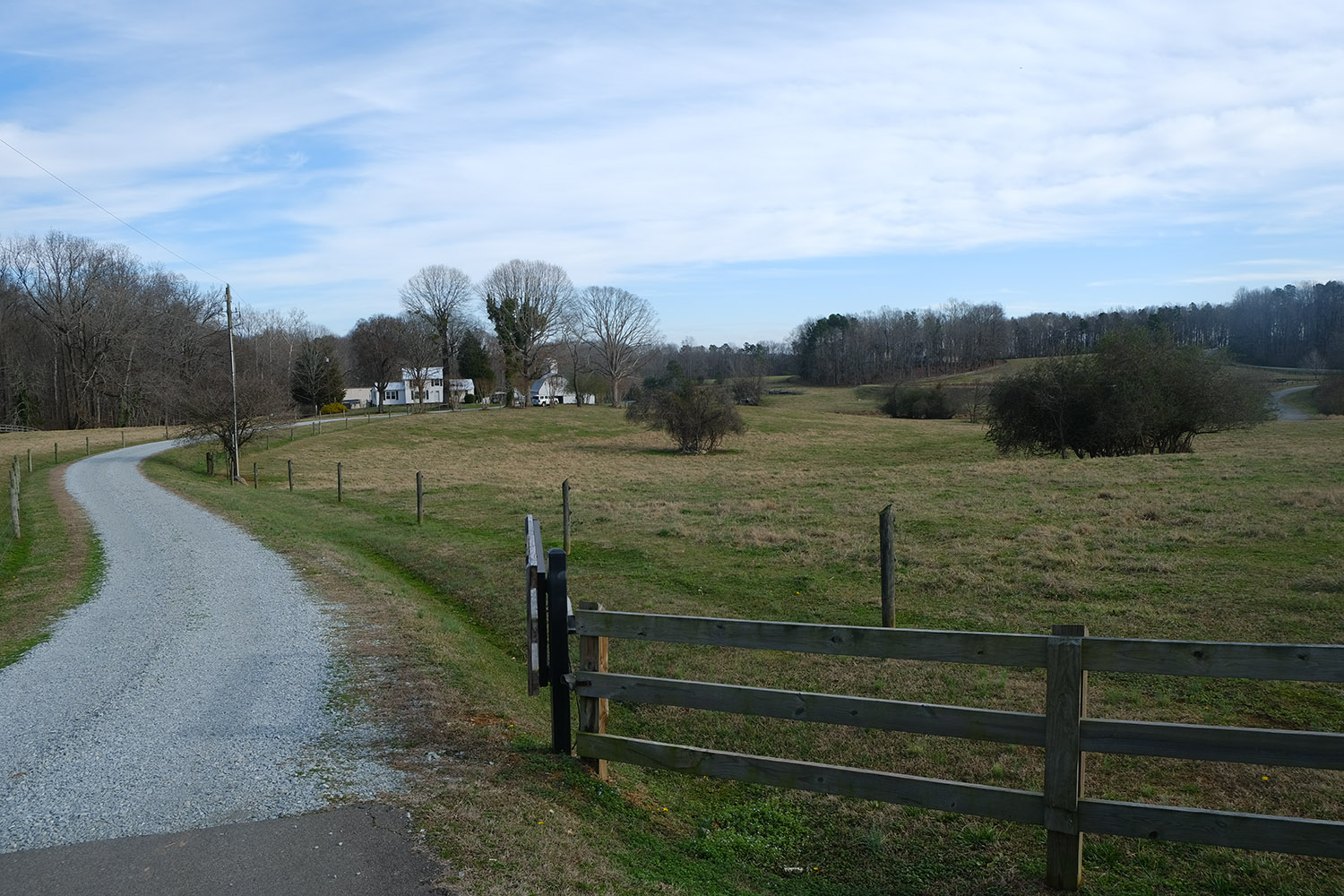
|
Astia/Soft Push/Pull: 0 EV ● Grain: Off ● Color Chrome: Weak ● White Balance: Auto ● WB Shift: R:0 B:0 ● more |

|
Acros + Red Filter Push/Pull: 0 EV ● B&W Adjustment: +3 ● Grain: Weak ● Color Chrome: Off ● White Balance: Auto ● WB Shift: R:+4 B:0 ● more |
When we are in Cannes, I often stroll around the old town and the harbor with my camera; it was during one of these outings that the photo I'm using for my second example was taken in August of 2019. In this case, I was not particularly looking for an out-of-camera JPEG, but with the raw file, it is a cinch to create JPEG files. The Fujifilm X Raw Studio software just makes it easier than using the small camera screen.
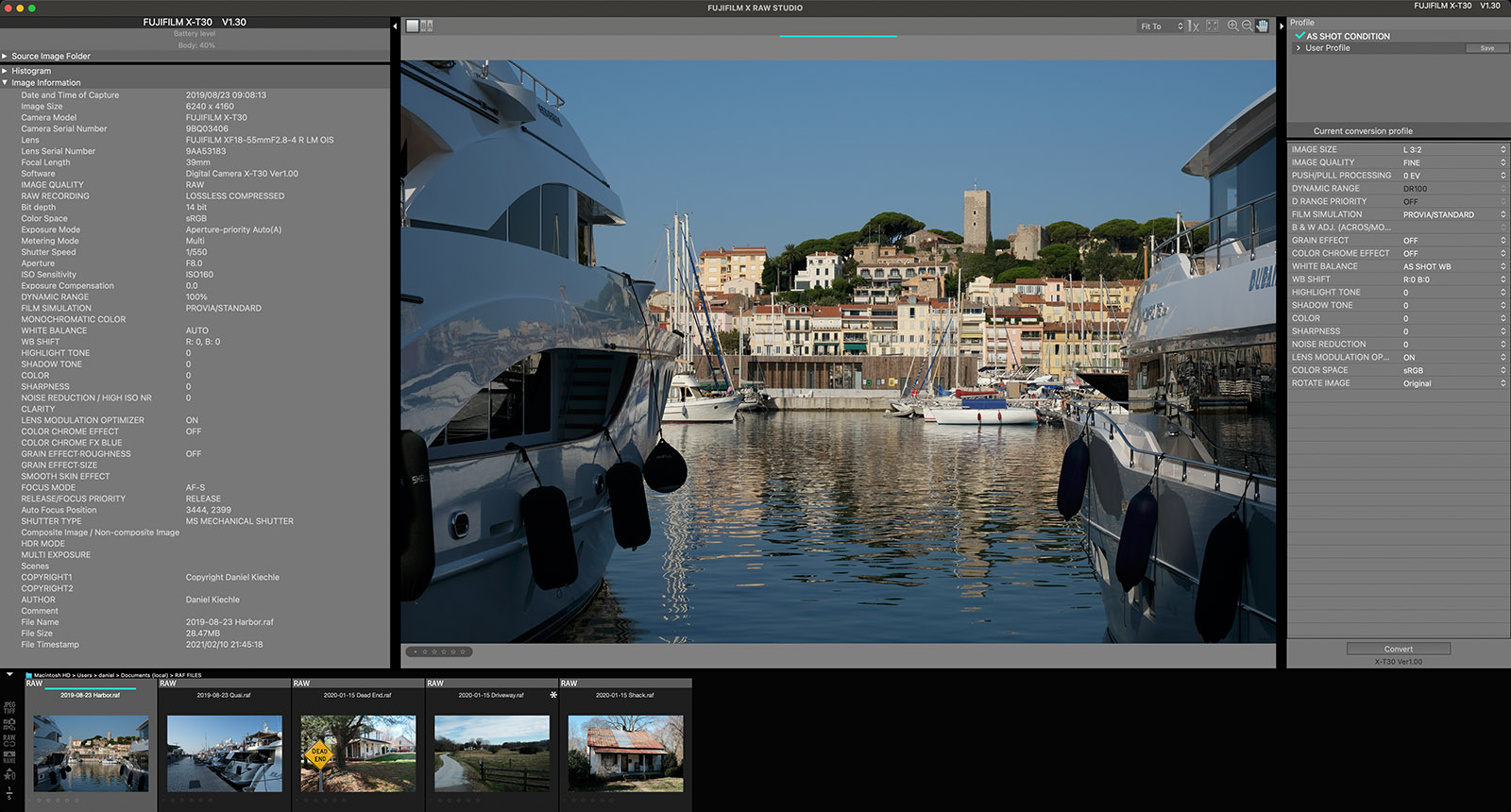
|
Click on any of the following four images to see a full-size version (6240 x 4160 pixels) or download an archive of all four.
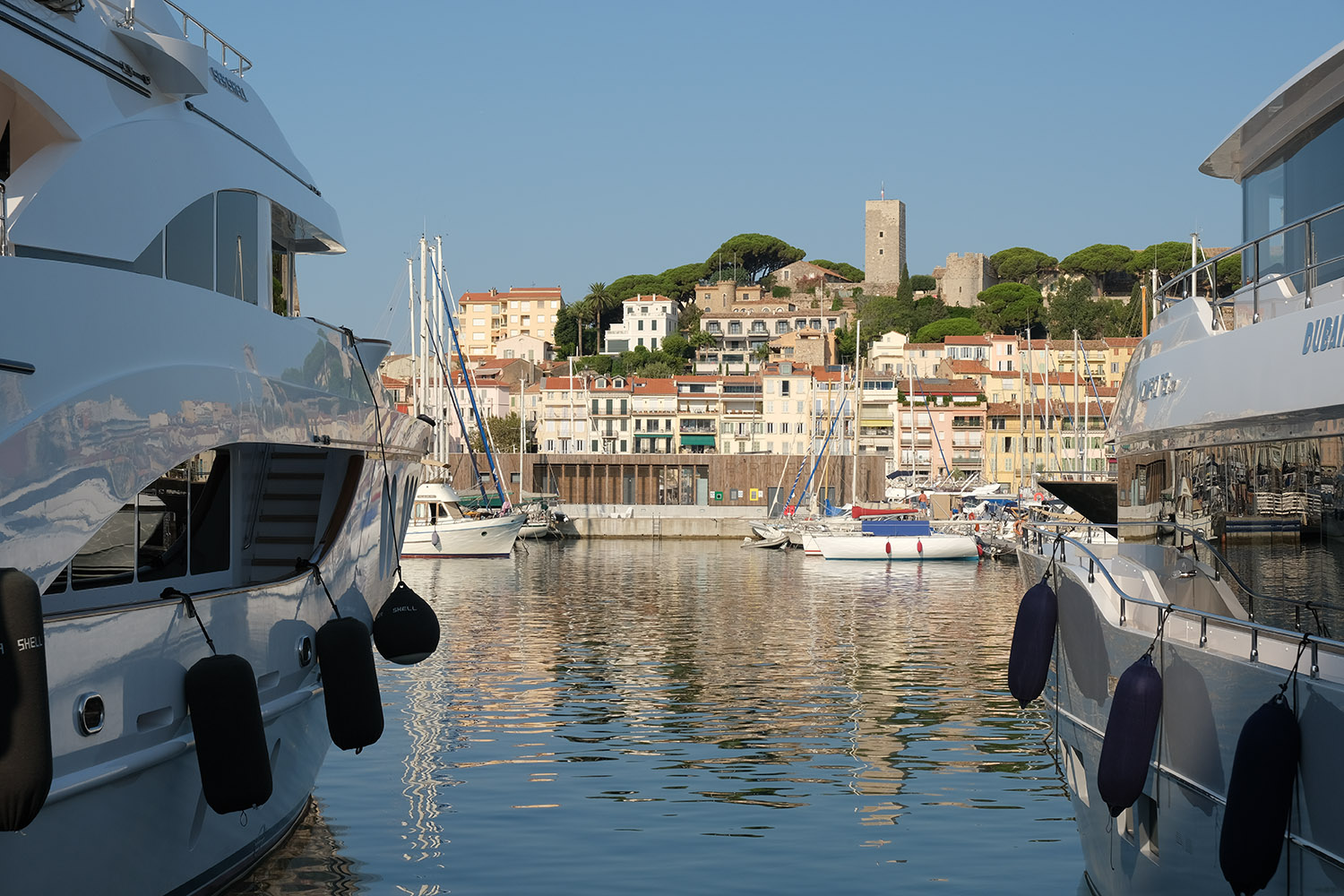
|
Provia/Standard Push/Pull: +⅔ EV ● Grain: Off ● Color Chrome: Off ● White Balance: Auto ● WB Shift: R:+1 B:-1 ● more |
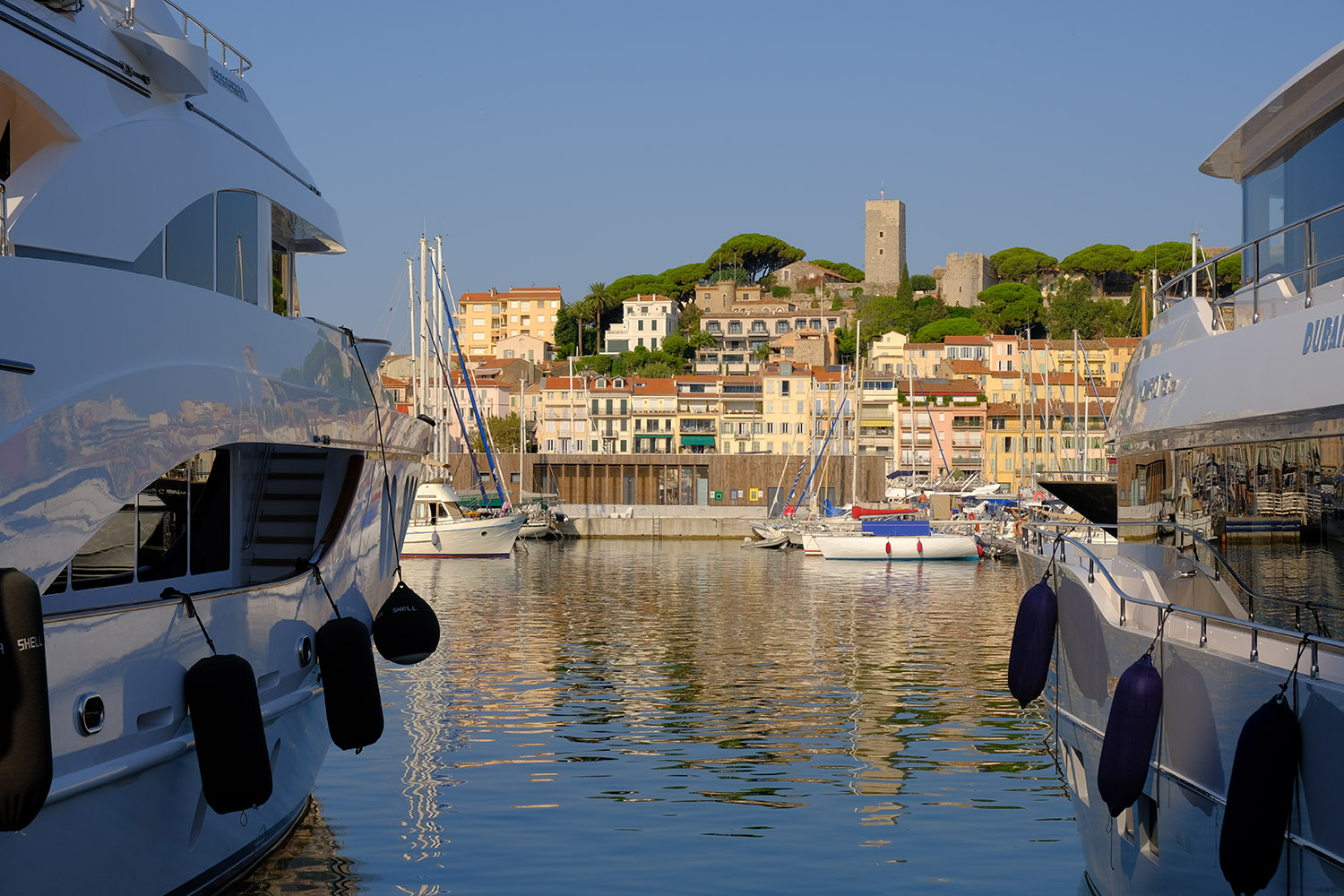
|
Velvia/Vivid Push/Pull: +⅓ EV ● Grain: Off ● Color Chrome: Off ● White Balance: Auto ● WB Shift: R:+2 B:-1 ● more |
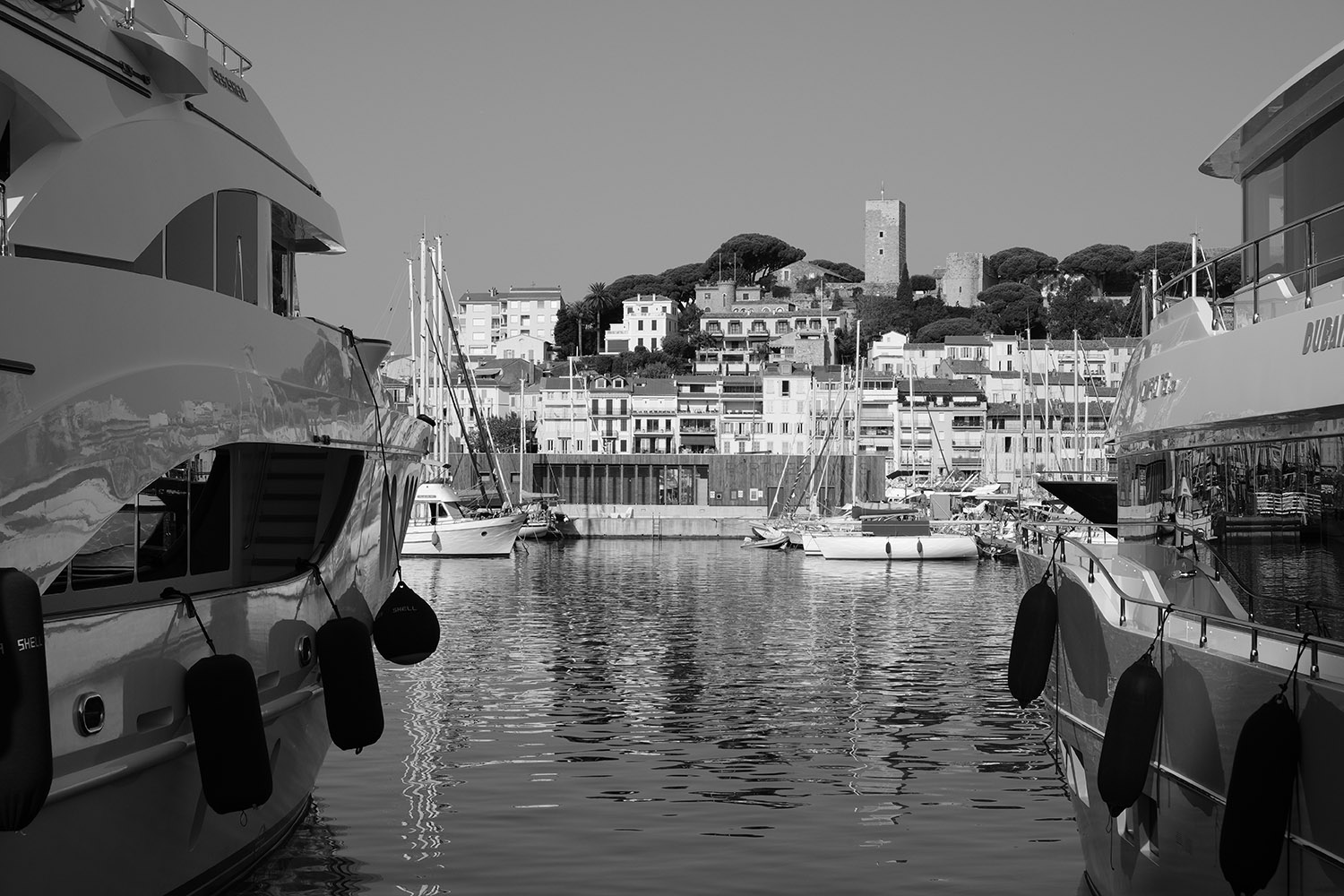
|
Acros Push/Pull: +⅓ EV ● B&W Adjustment: 0 ● Grain: Off ● Color Chrome: Off ● White Balance: Auto ● WB Shift: R:+1 B:-1 ● more |
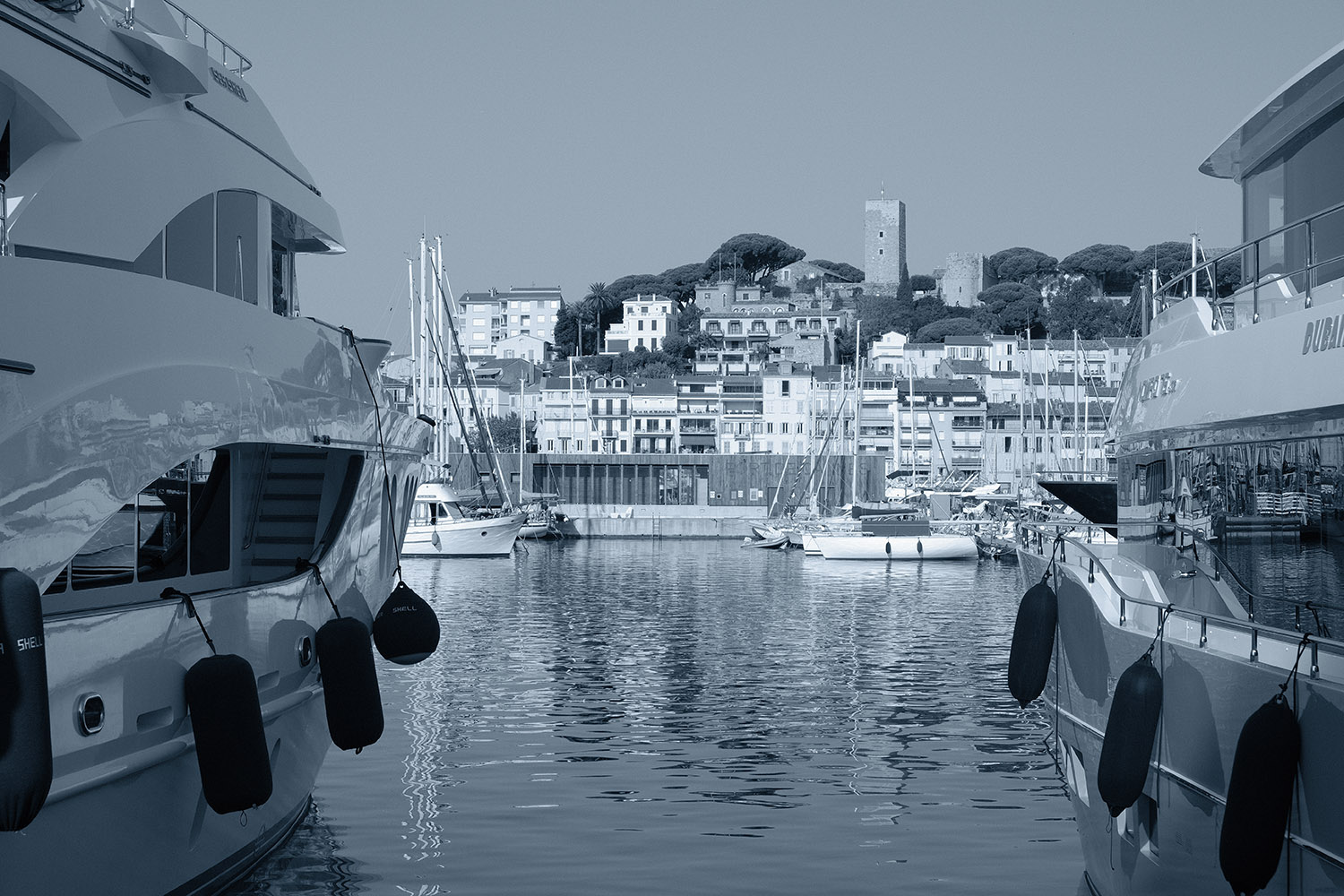
|
Monochrome + Green Filter Push/Pull: +⅔ EV ● B&W Adjustment: -9 ● Grain: Weak ● Color Chrome: Off ● White Balance: Auto ● WB Shift: R:+1 B:-1 ● more |
On February 16, 2021, we had to drive to Eden, North Carolina, about one hour and a half from our home in Chapel Hill. Knowing that I would need some out-of-camera JPEGs for this page, I availed myself of the opportunity to take a few photos with a new set of JPEG parameters based on the Pro Neg. Standard simulation, and I chose one of those images as my next example.
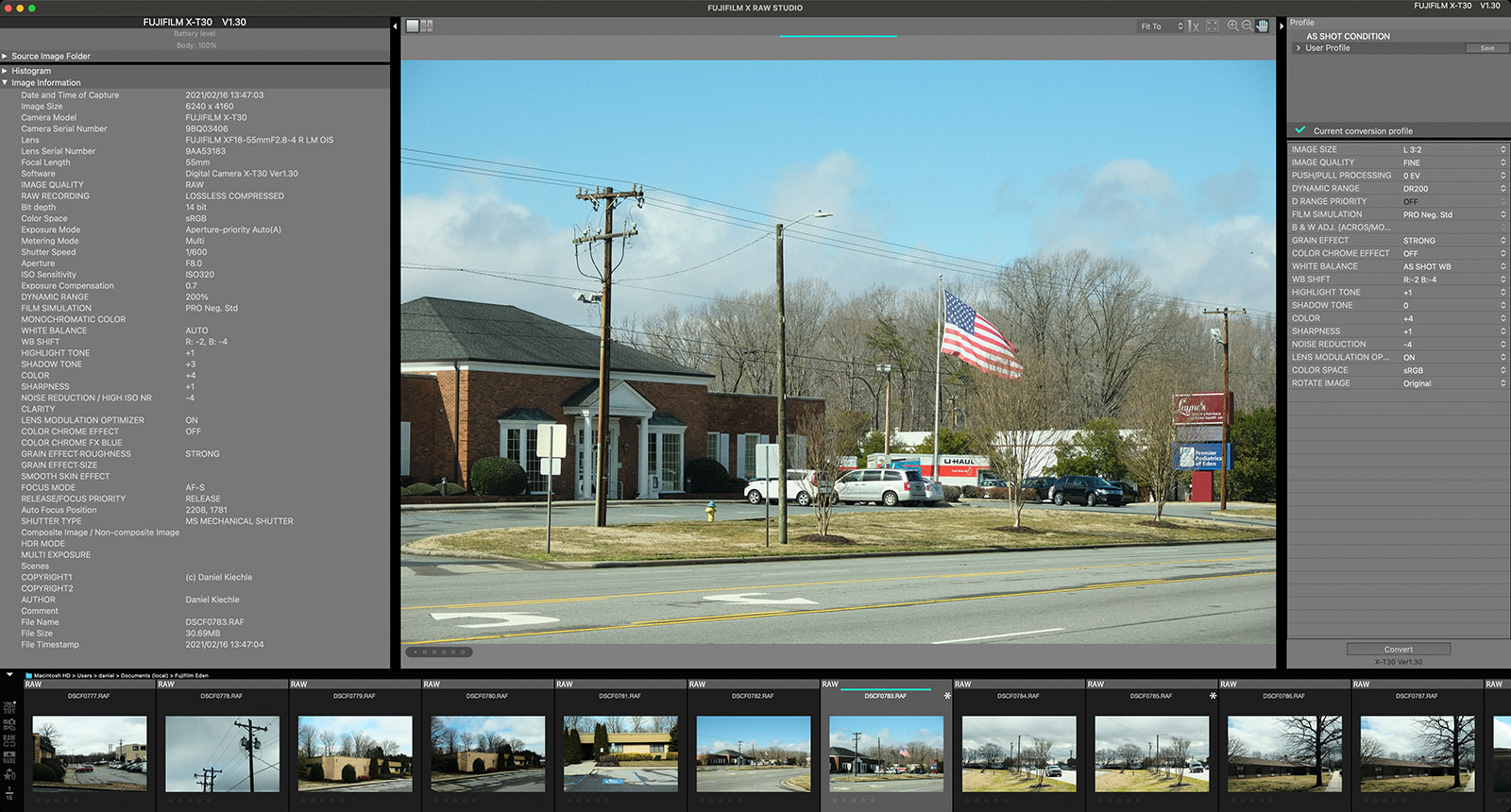
|
Click on any of the following four images to see a full-size version (6240 x 4160 pixels) or download an archive of all four.
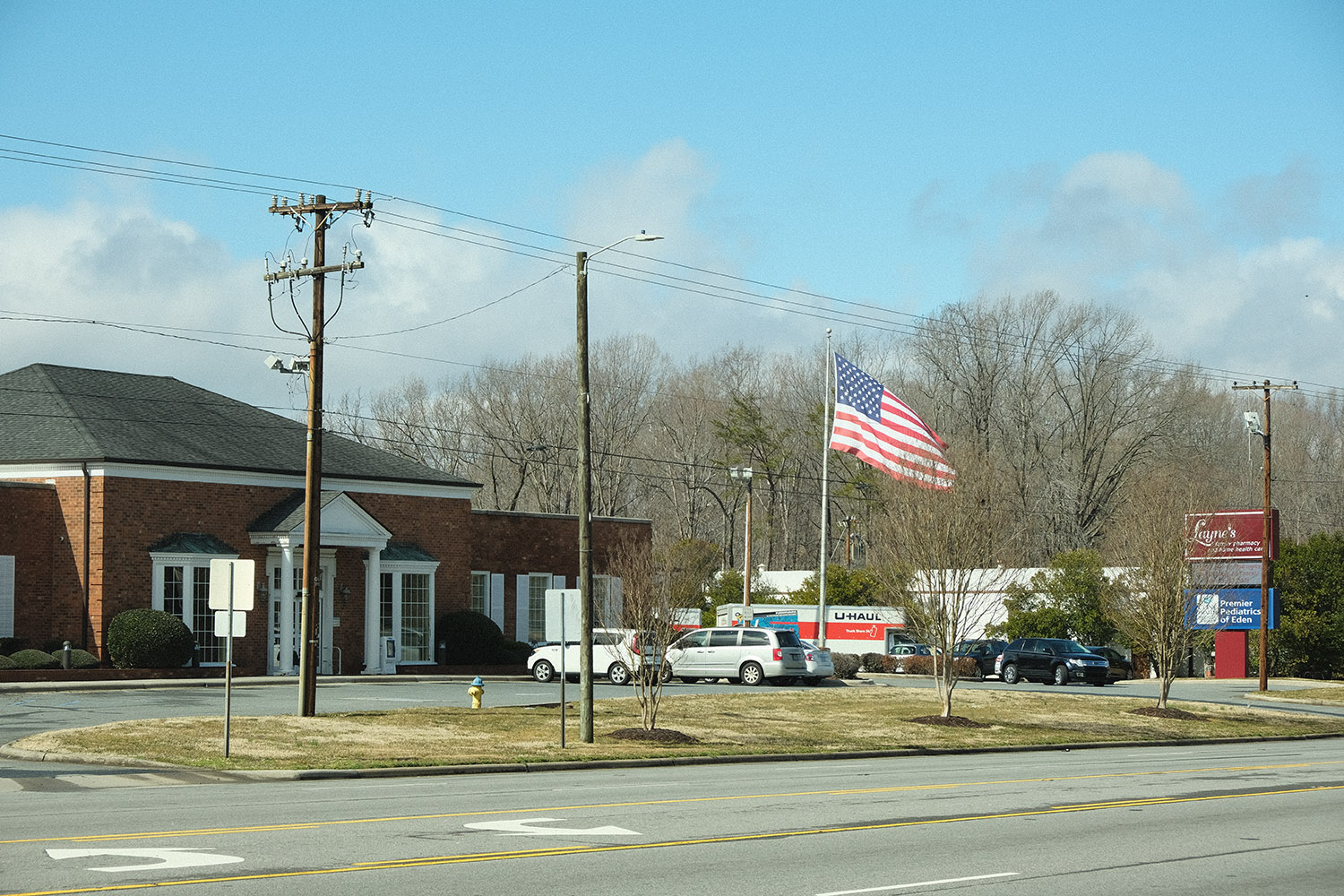
|
Pro Neg. Standard Push/Pull: 0 EV ● Grain: Strong ● Color Chrome: Off ● White Balance: as shot ● WB Shift: R:-2 B:-4 ● more |
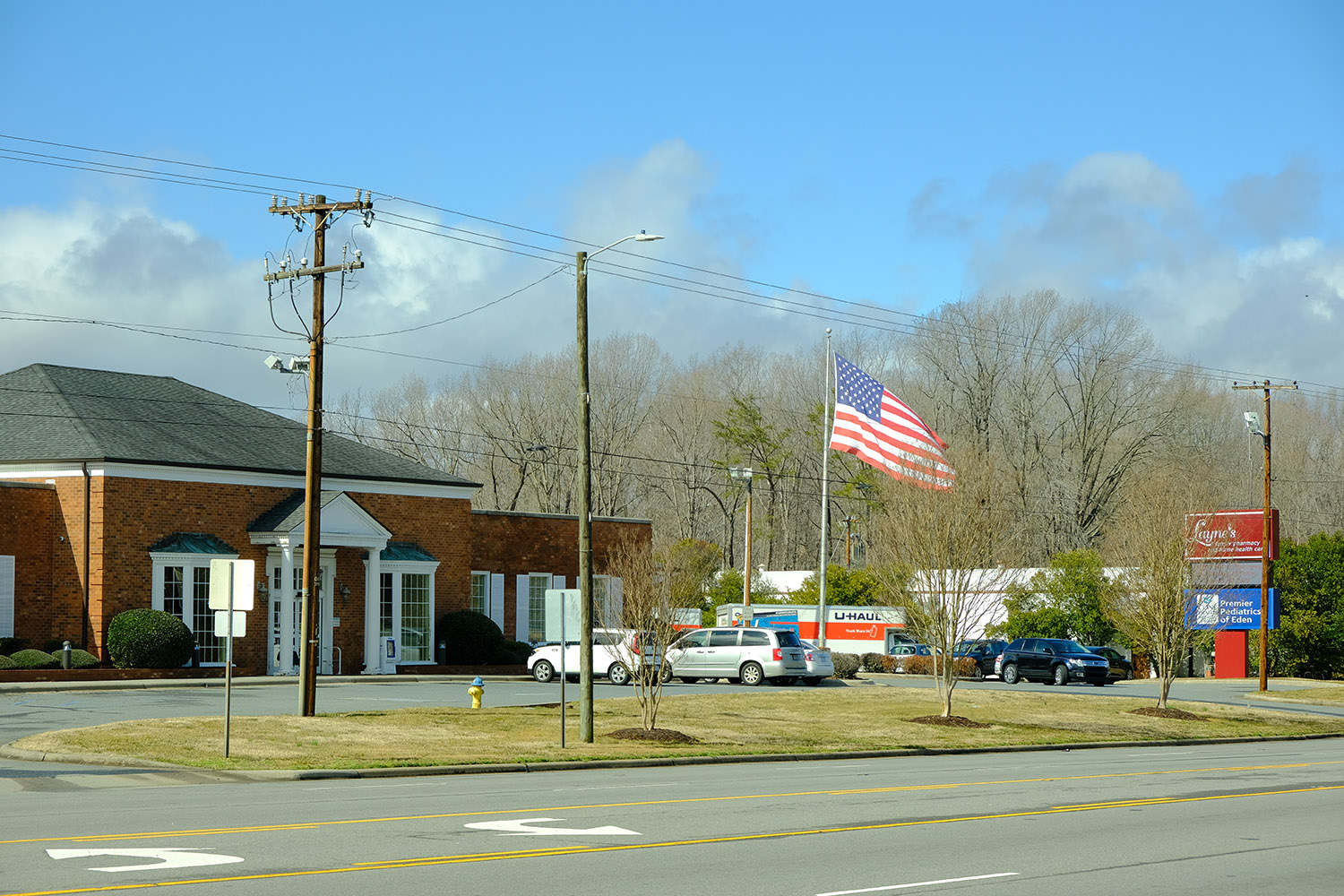
|
Velvia/Vivid Push/Pull: +⅓ EV ● Grain: Off ● Color Chrome: Off ● White Balance: Auto ● WB Shift: R:-2 B:-4 ● more |
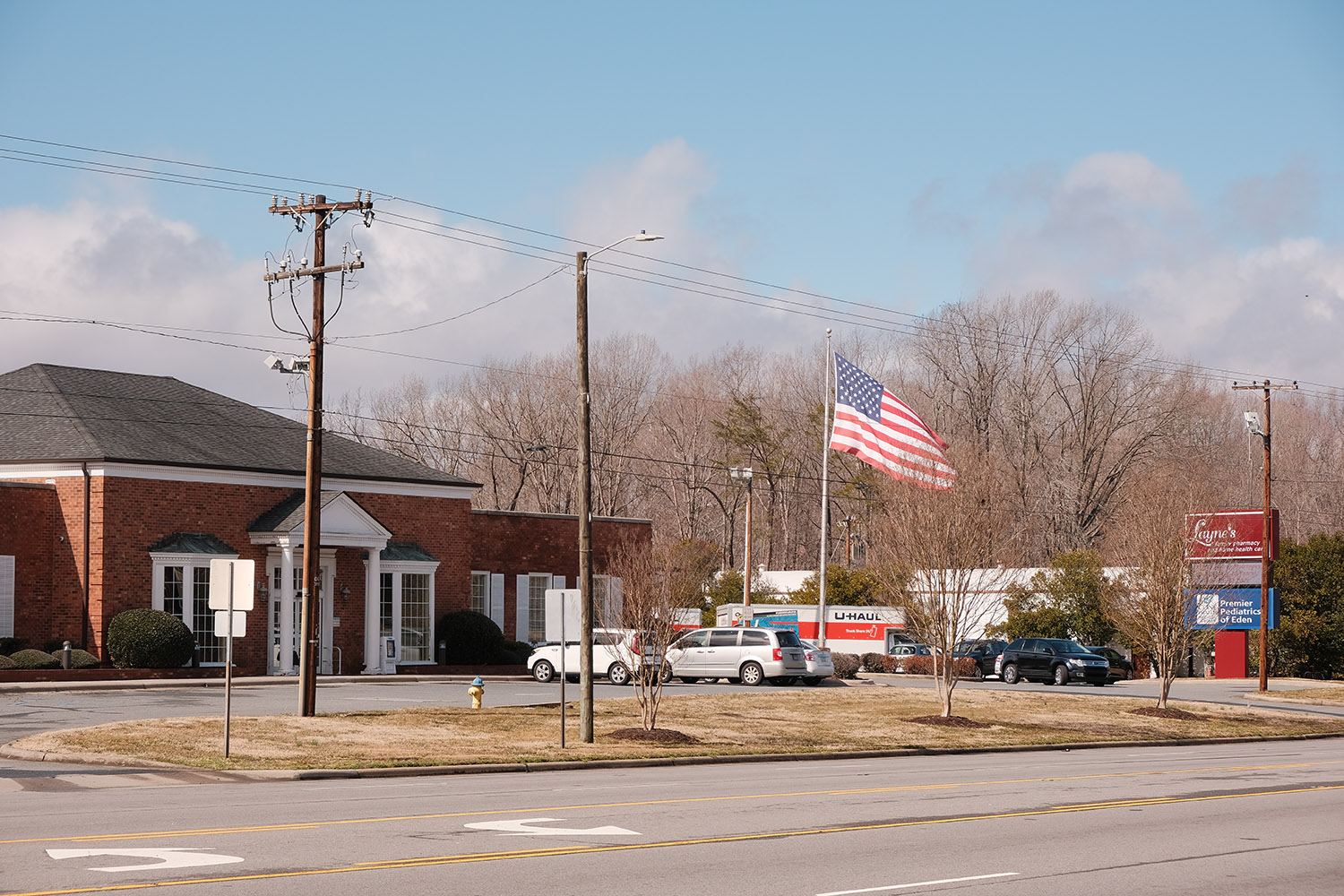
|
Classic Chrome Push/Pull: 0 EV ● Grain: Off ● Color Chrome: Strong ● White Balance: 6300K ● WB Shift: R:+1 B:+3 ● more |
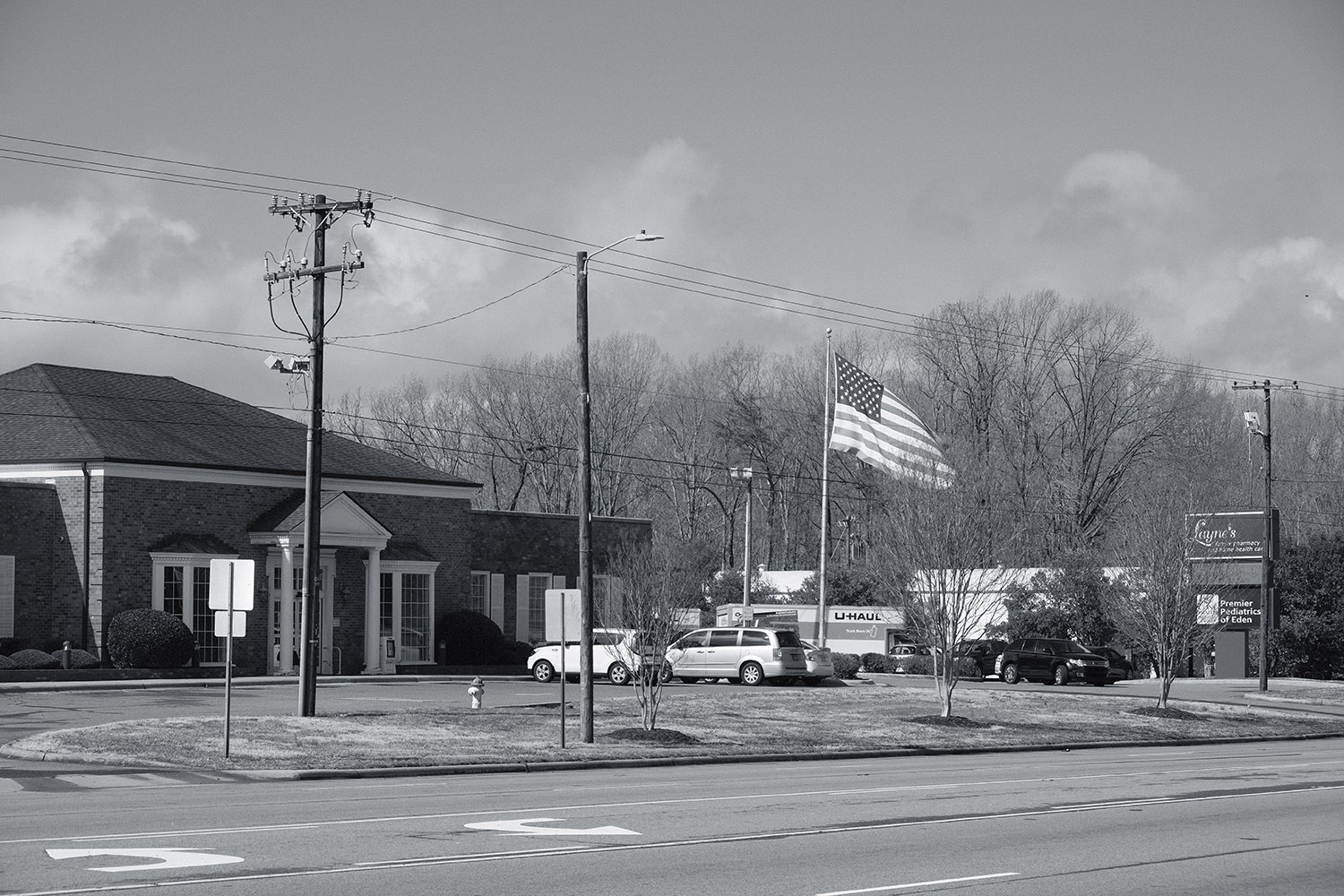
|
Acros + Yellow Filter Push/Pull: -⅓ EV ● B&W Adjustment: -2 ● Grain: Weak ● Color Chrome: Off ● White Balance: Daylight ● WB Shift: R:+1 B:+3 ● more |
Right in the Southern Village part of Chapel Hill, a mere few yards from our place, is Fan Branch Trail, a short but scenic walk through the neighborhood. On February 17, 2021, I strolled through it with the purpose of taking a couple of photos for this page. It was just after 4 p.m. and the sun was low in the sky already, so the light came in at an angle and the shadows were long. I used the Pro Neg. Hi simulation for this one.
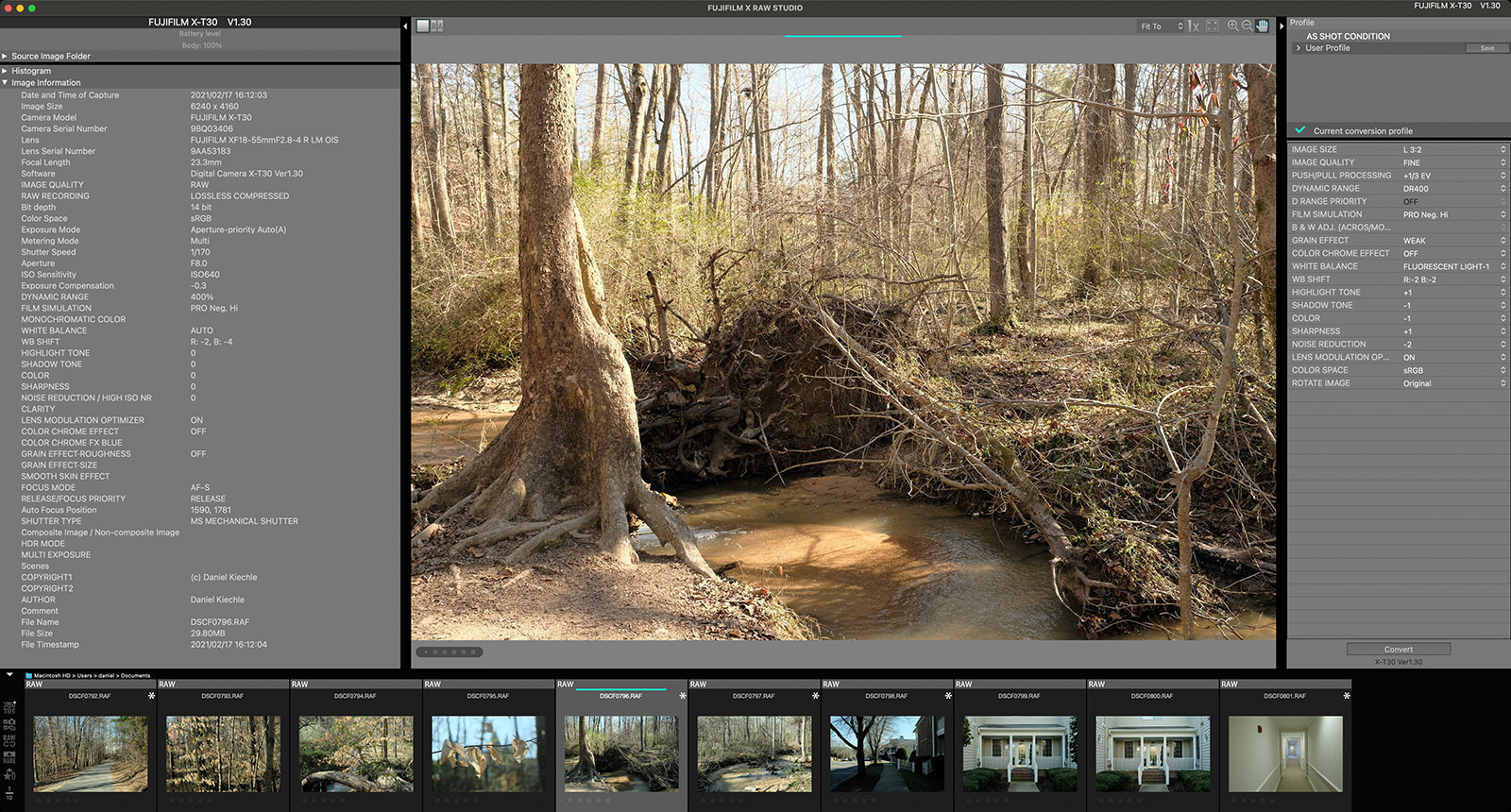
|
Click on any of the following four images to see a full-size version (6240 x 4160 pixels) or download an archive of all four.
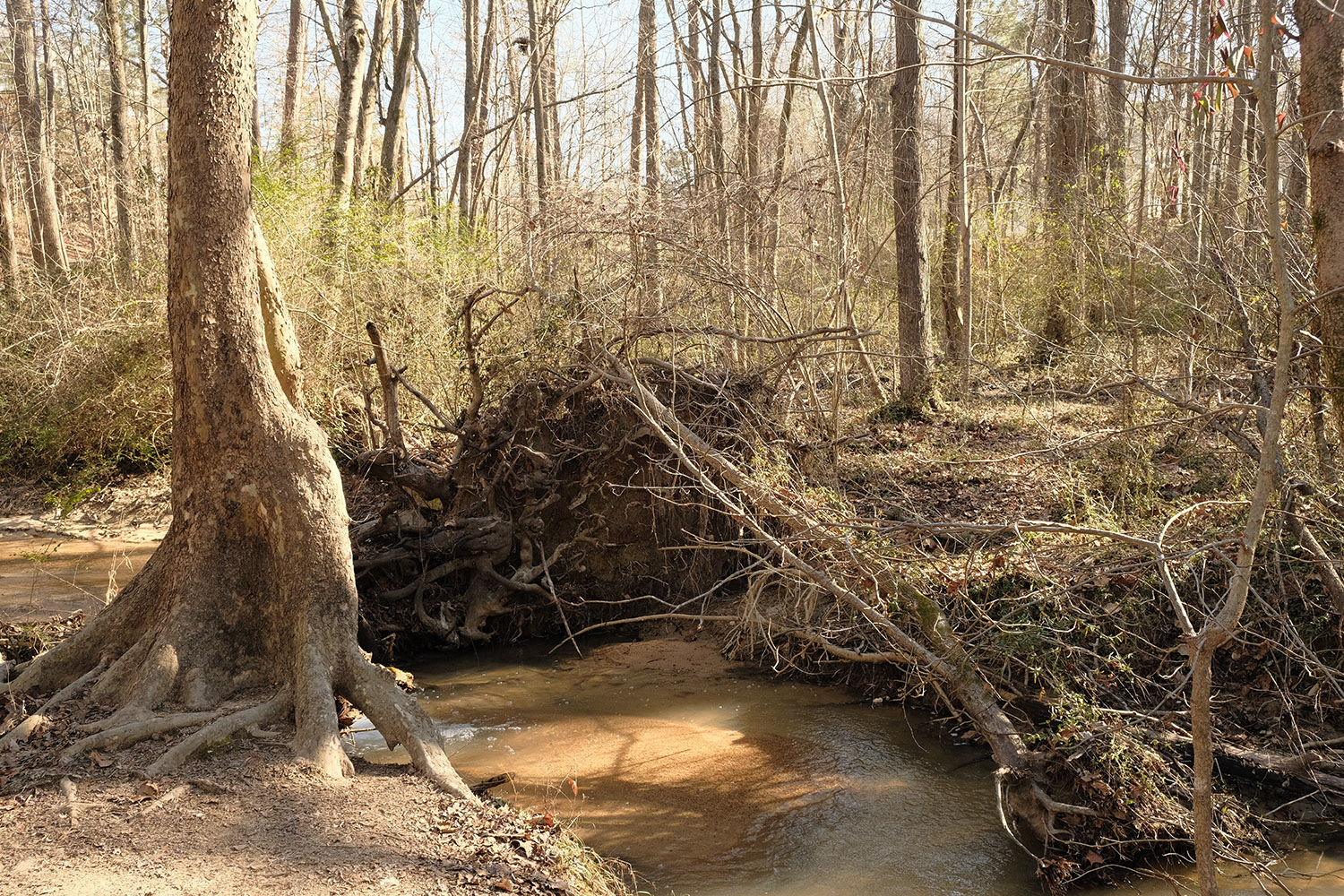
|
Pro Neg. Hi Push/Pull: +⅓ EV ● Grain: Weak ● Color Chrome: Off ● White Balance: Fluorescent Light -1 ● WB Shift: R:-2 B:-2 ● more |
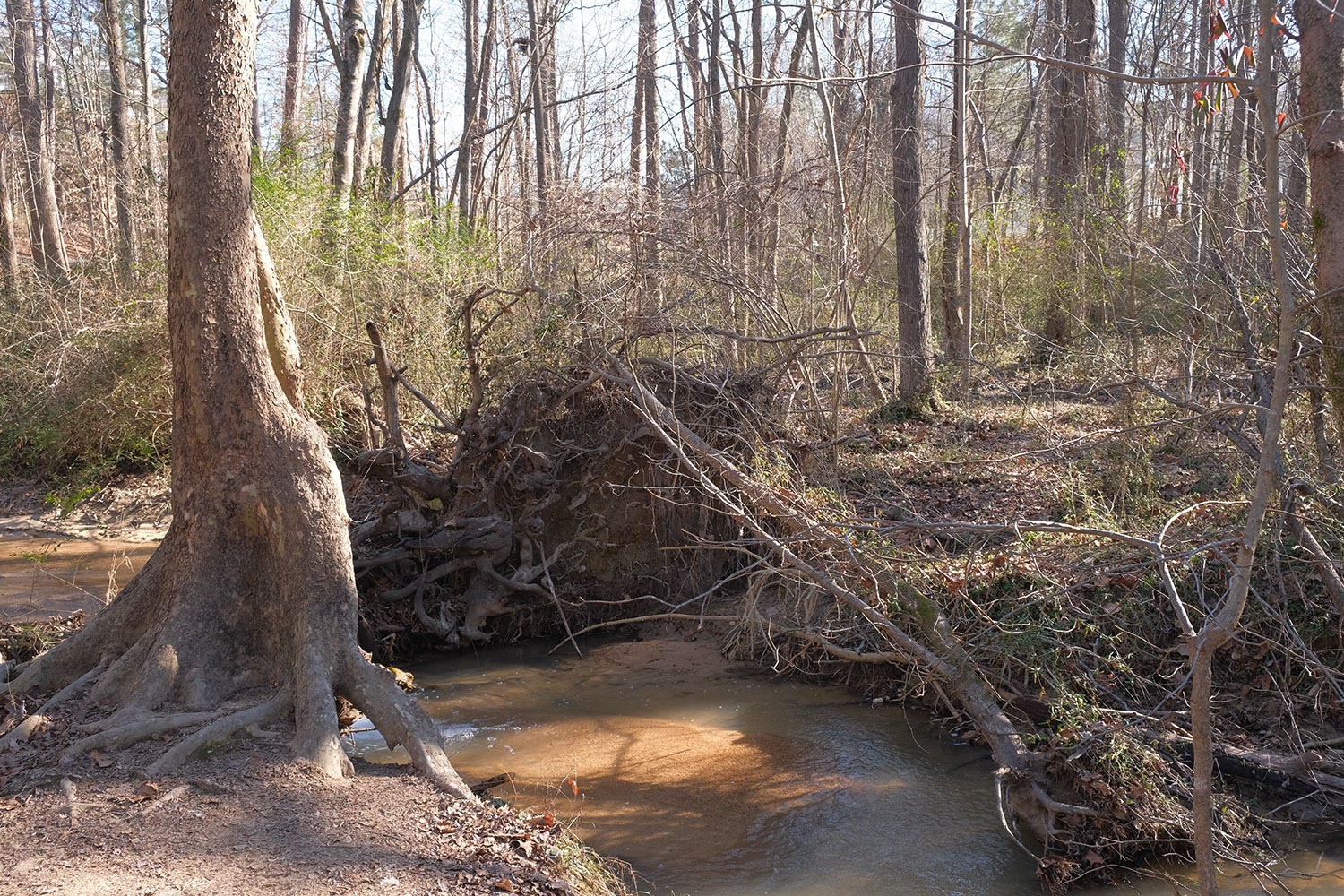
|
Provia/Standard Push/Pull: 0 EV ● Grain: Off ● Color Chrome: Off ● White Balance: Auto ● WB Shift: R:+2 B:-1 ● more |
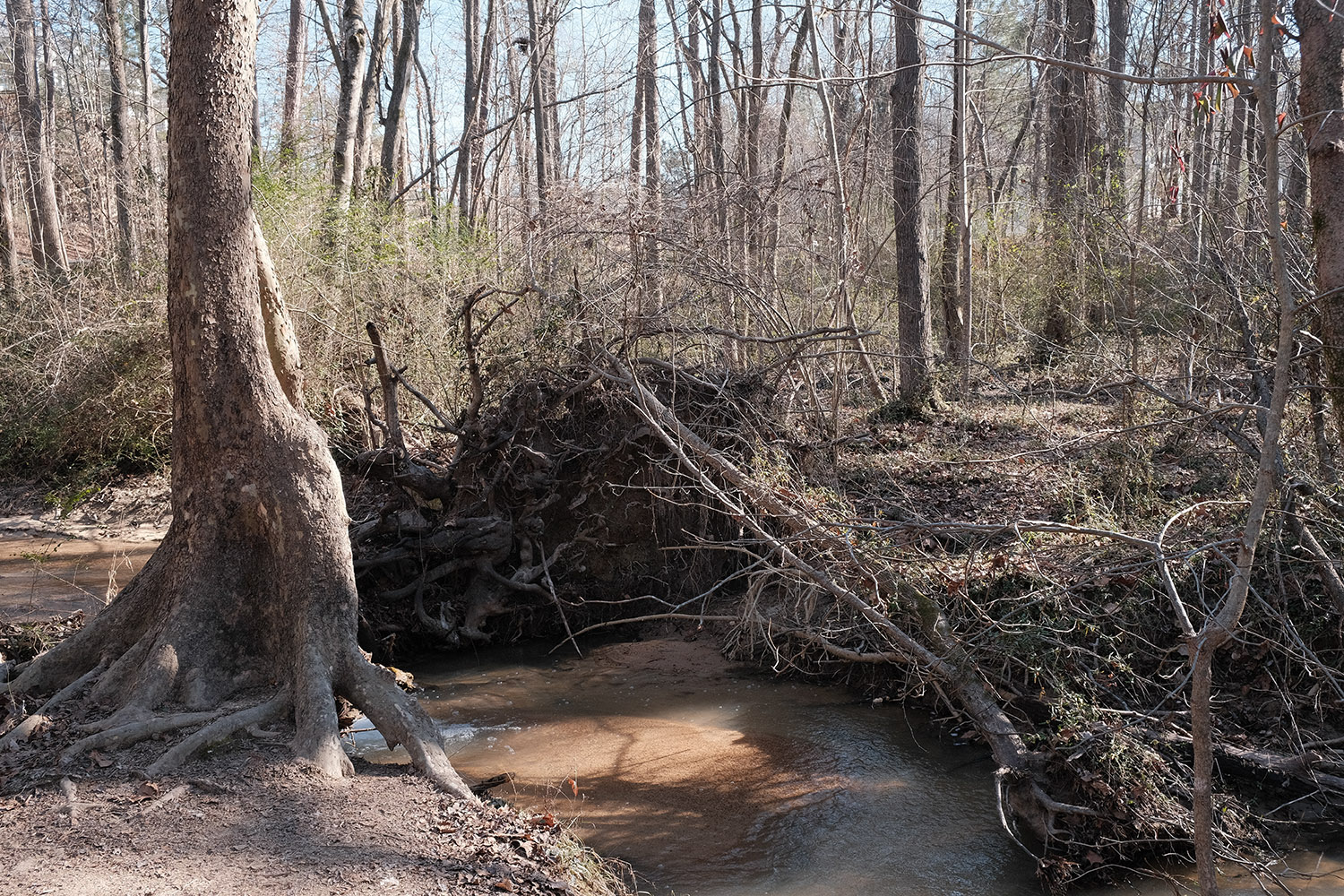 |
Classic Chrome Push/Pull: 0 EV ● Grain: Weak ● Color Chrome: Strong ● White Balance: Daylight ● WB Shift: R:+1 B:+2 ● more |
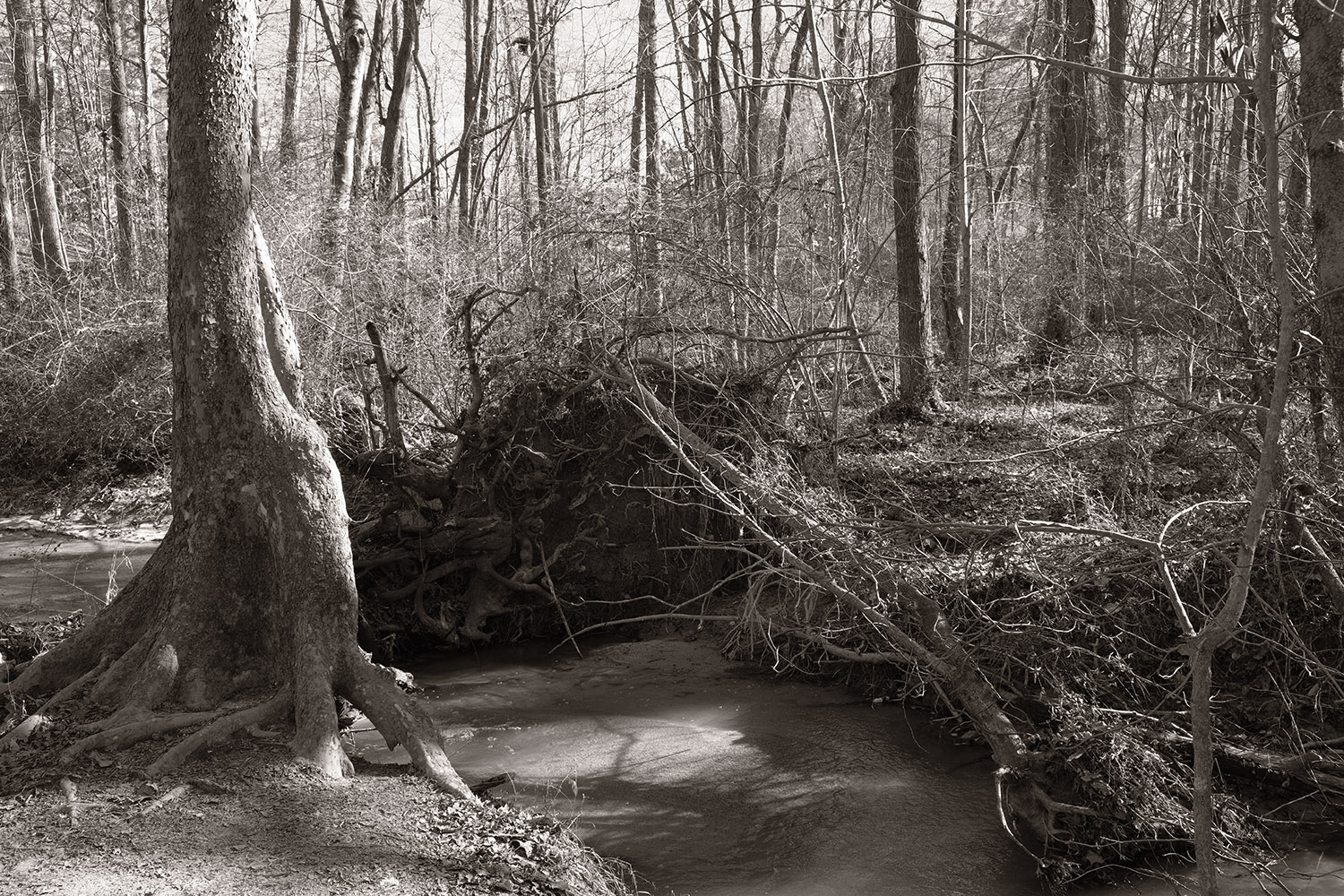
|
Acros + Yellow Filter Push/Pull: -⅓ EV ● B&W Adjustment: +3 ● Grain: Weak ● Color Chrome: Off ● White Balance: Shade ● WB Shift: R:-3 B:-2 ● more |
We'll head back to France for this last example. Like the first Cannes photo, this one was taken in August of 2019, and I did not tweak the simulation in any way. Indeed, the parameters of the JPEG file are the defaults applied when shooting raw + JPEG. My purpose was mostly to familiarize myself with the X-T30, a camera I had purchased just two days earlier. I shot in raw + JPEG but without specifying a particular simulation, so the default Provia/Standard was used.
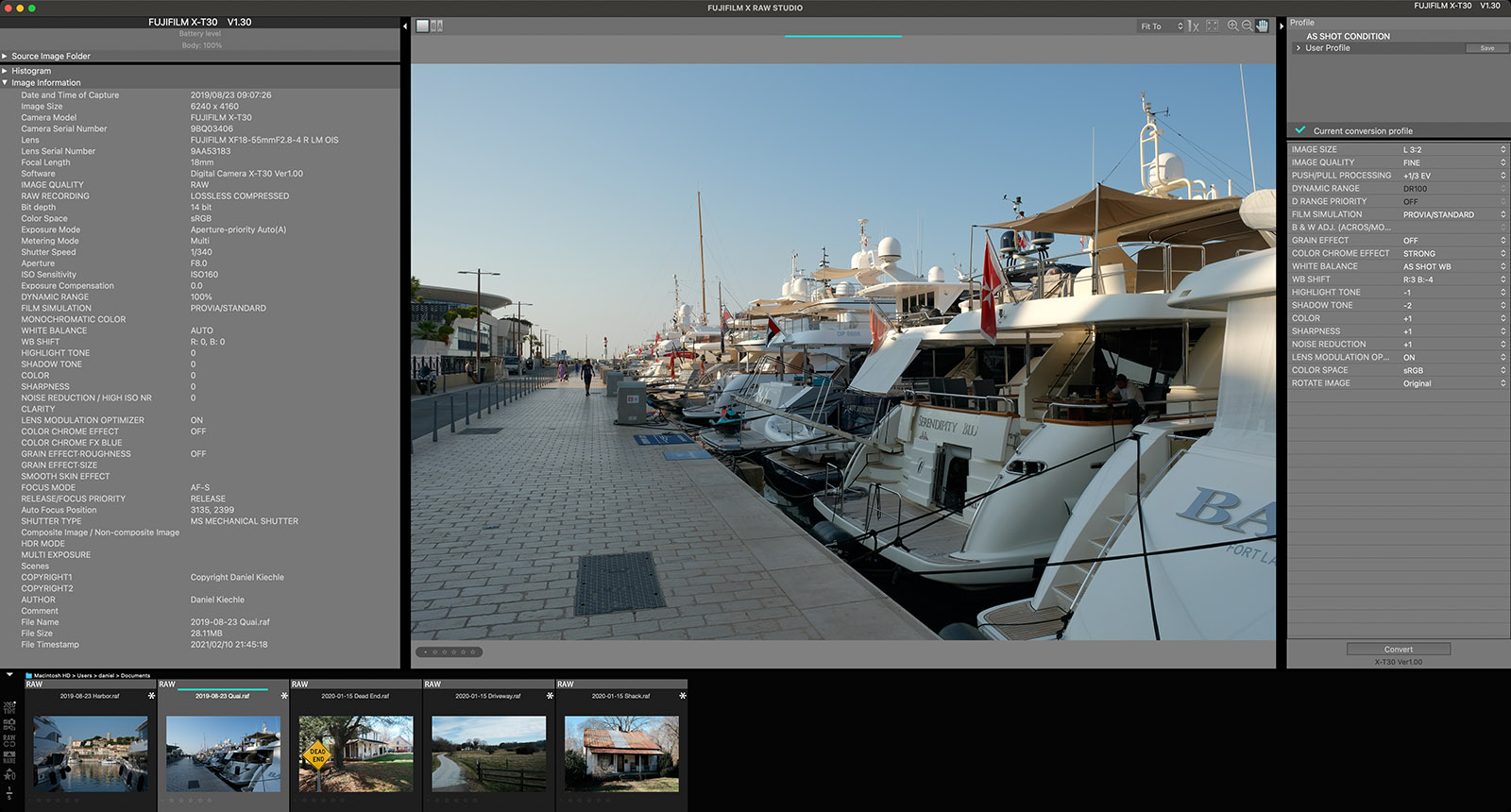
|
Click on any of the following four images to see a full-size version (6240 x 4160 pixels) or download an archive of all four.
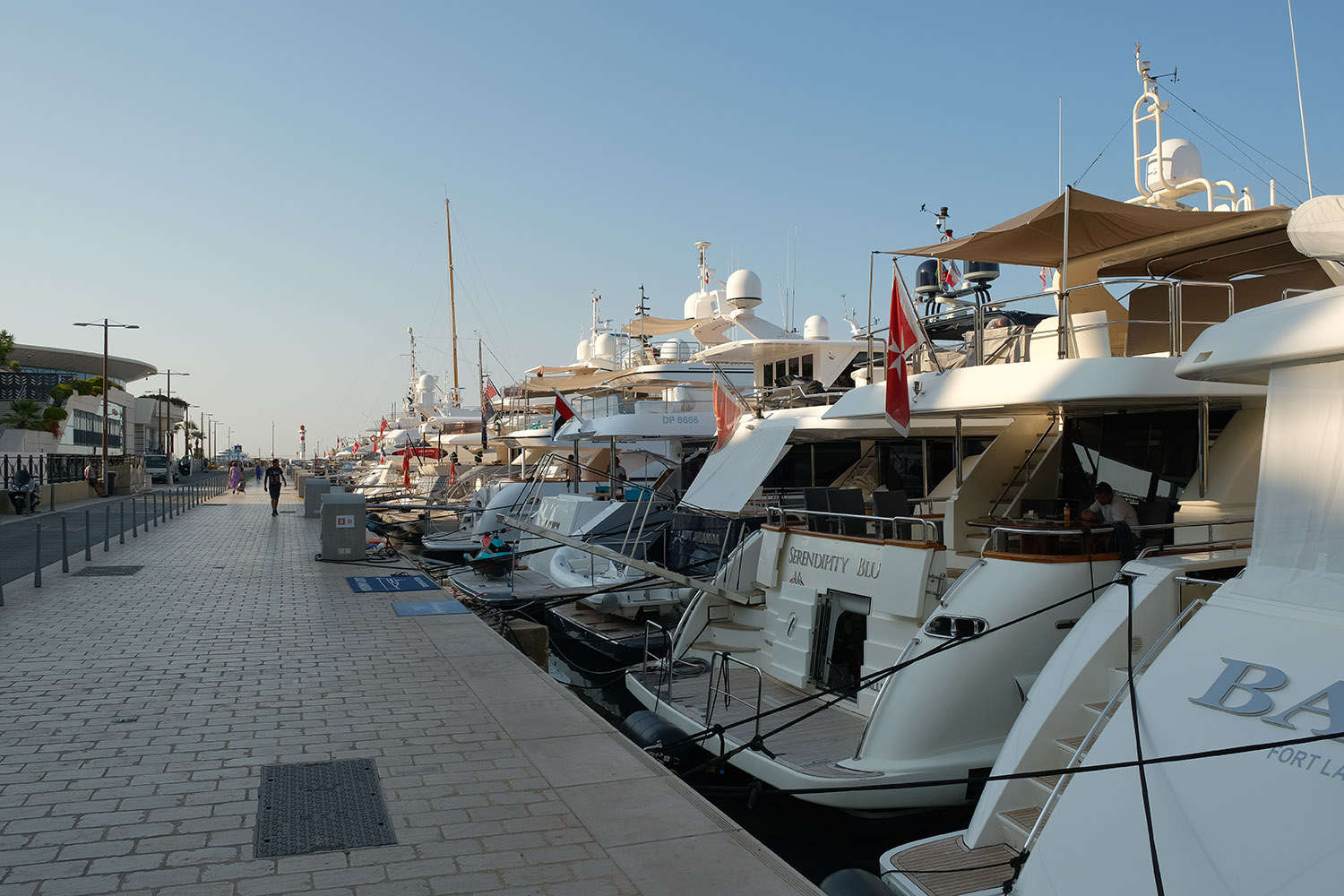
|
Provia/Standard Push/Pull: +⅓ EV ● Grain: Off ● Color Chrome: Strong ● White Balance: As shot ● WB Shift: R:+3 B:-4 ● more |
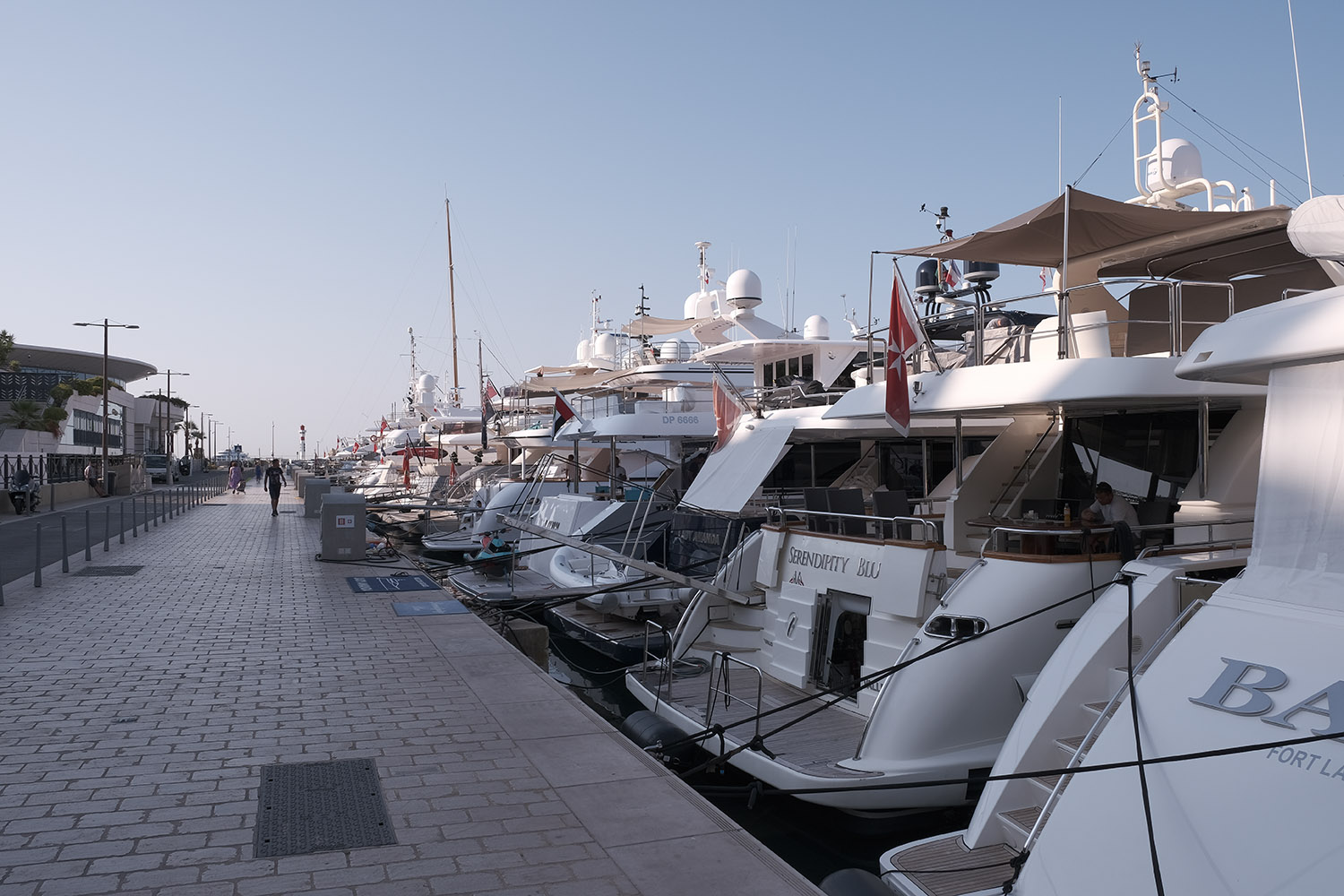
|
Eterna/Cinema Push/Pull: +⅓ EV ● Grain: Off ● Color Chrome: Weak ● White Balance: Auto ● WB Shift: R:+4 B:+2 ● more |
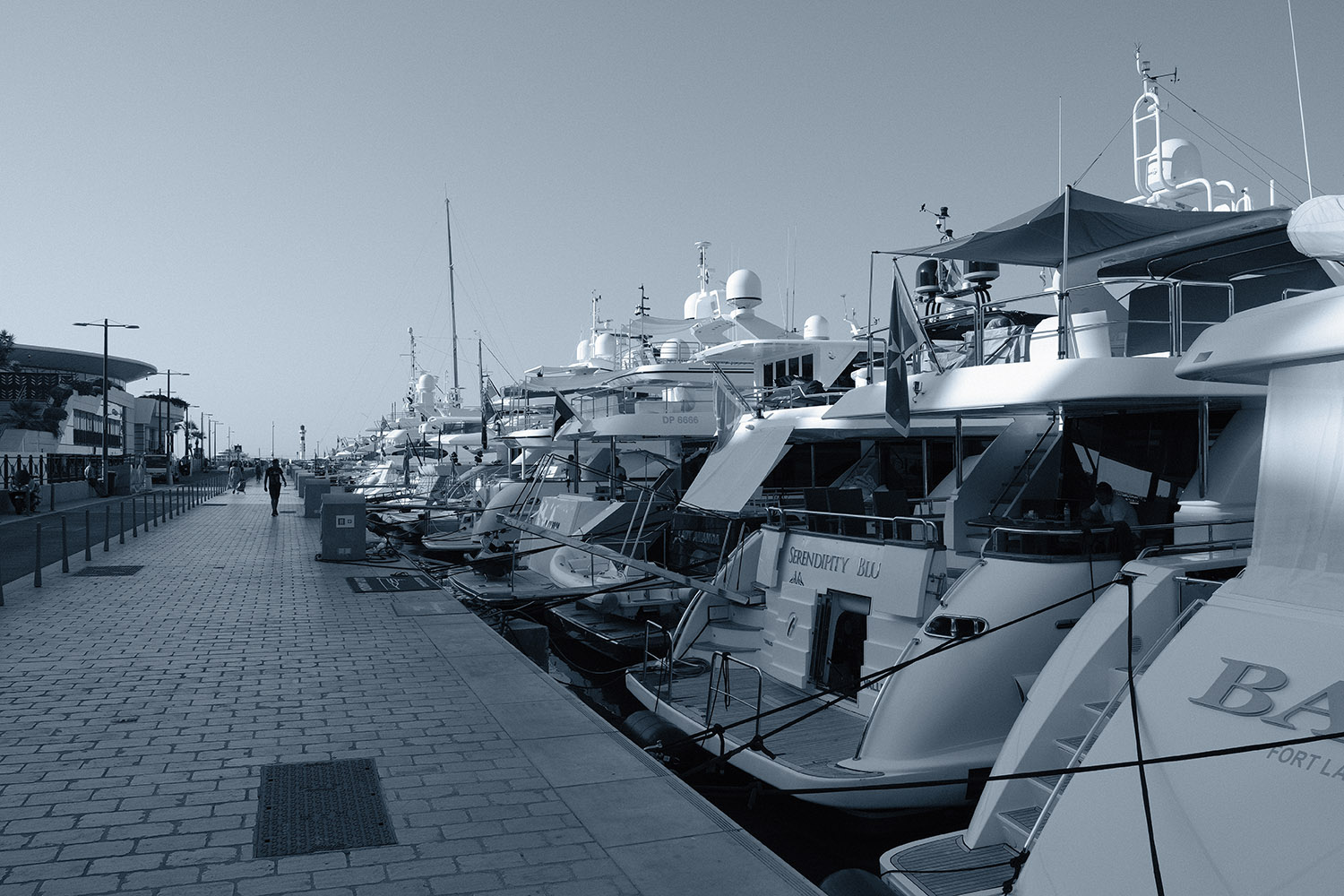
|
Acros Push/Pull: +⅓ EV ● B&W Adjustment: -8 ● Grain: Weak ● Color Chrome: Off ● White Balance: Daylight ● WB Shift: R:-3 B:-2 ● more |
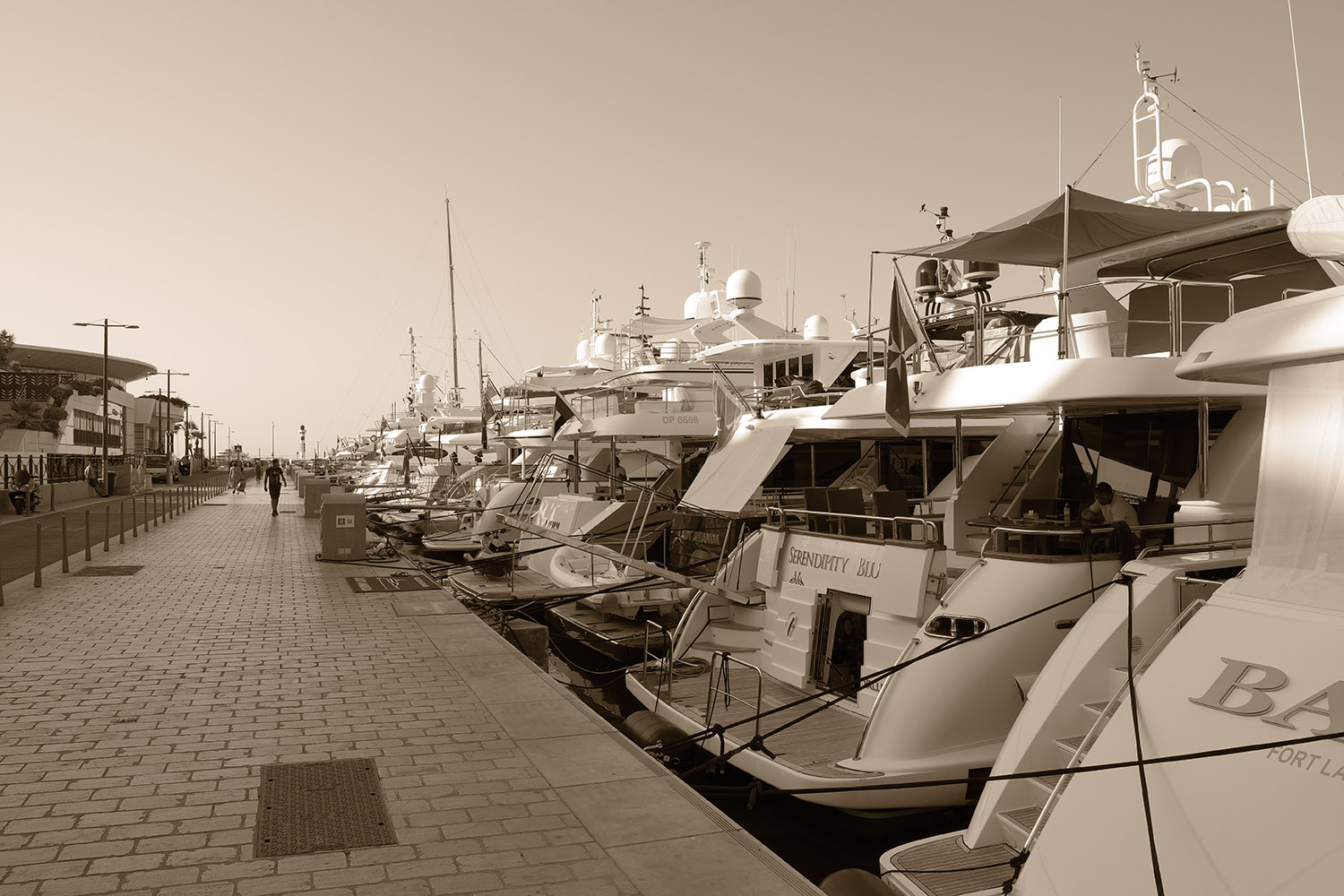
|
Acros + Green Filter Push/Pull: +⅔ EV ● B&W Adjustment: +9 ● Grain: Weak ● Color Chrome: Off ● White Balance: Daylight ● WB Shift: R:0 B:0 ● more |
One thing to keep in mind is that Fujifilm X Raw Studio only works with unmodified RAF (Fujifilm raw) files. For instance, I use the amazingly useful Geotag Photos Pro software with my iPhone to geotag all my photos. The product comes with a desktop application that permits storing the location data in a sidecar file associated with each image, or inside the raw file itself. Raw files that have been modified this way will cause the Fujifilm X Raw Studio software to crash.
It's important to realize that nothing we have done on this page constitutes any kind of post-processing in the sense I described it on this page. All we have done is to use built-in features of the camera to produce photos in the JPEG format. These manipulations could have been done just as easily (albeit not as conveniently) with the camera before taking the pictures.
Obviously, these JPEG images could be processed further using traditional photo editing software, but the point is that this would only require minimal adjustments, if any at all. What one obtains out of camera is really excellent already. To my eye, these images do not have the sterile appearance so often associated with digital JPEGs; rather, they can have a more film-like feel that varies with the chosen simulation and parameter settings.
Alaska-based professional photographer and Fujifilm ambassador Dan Bailey hardly ever shoots in raw with his Fujifilm X Series cameras. He is able to achieve his remarkable results by mostly shooting in JPEG. Take a look at his work, and if you are a Fujifilm shooter, by all means check out Dan's comprehensive eBook X Series Unlimited. I find it to be an excellent resource.
Home | Site Info | Family | The Area | Trips | France | Work | Rants | Photography | Odds & Ends
This page was last modified on March 1, 2021
Send feedback about this page to feedback@kiechle.com
https://www.kiechle.com/photography/xrawstudio/index.htm
(optimized for Retina display)
All contents © 1999-2025 The Kiechles